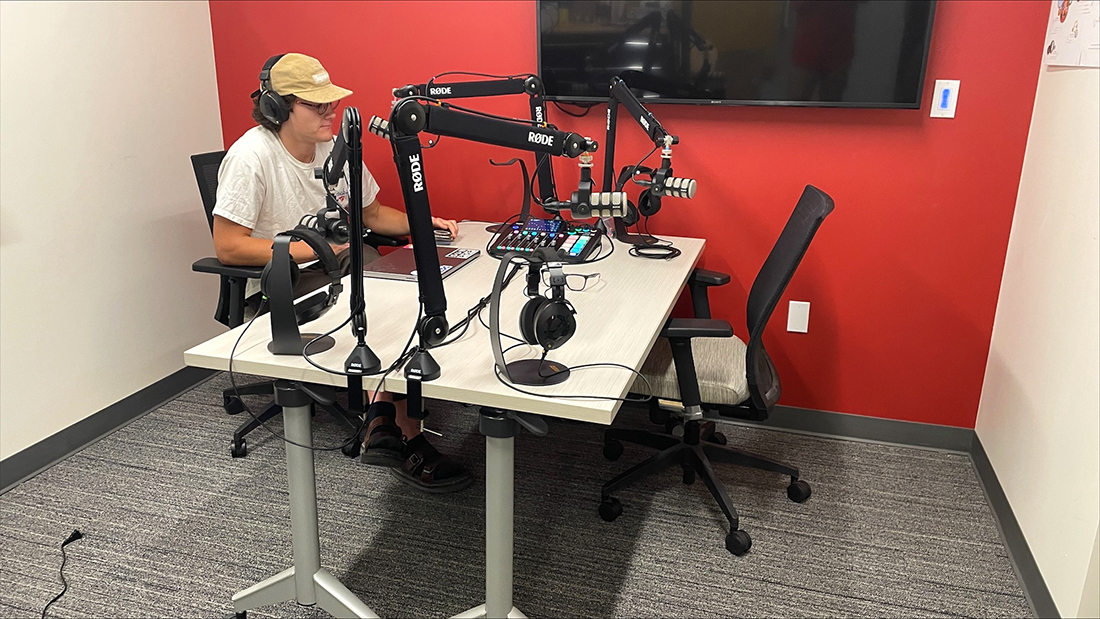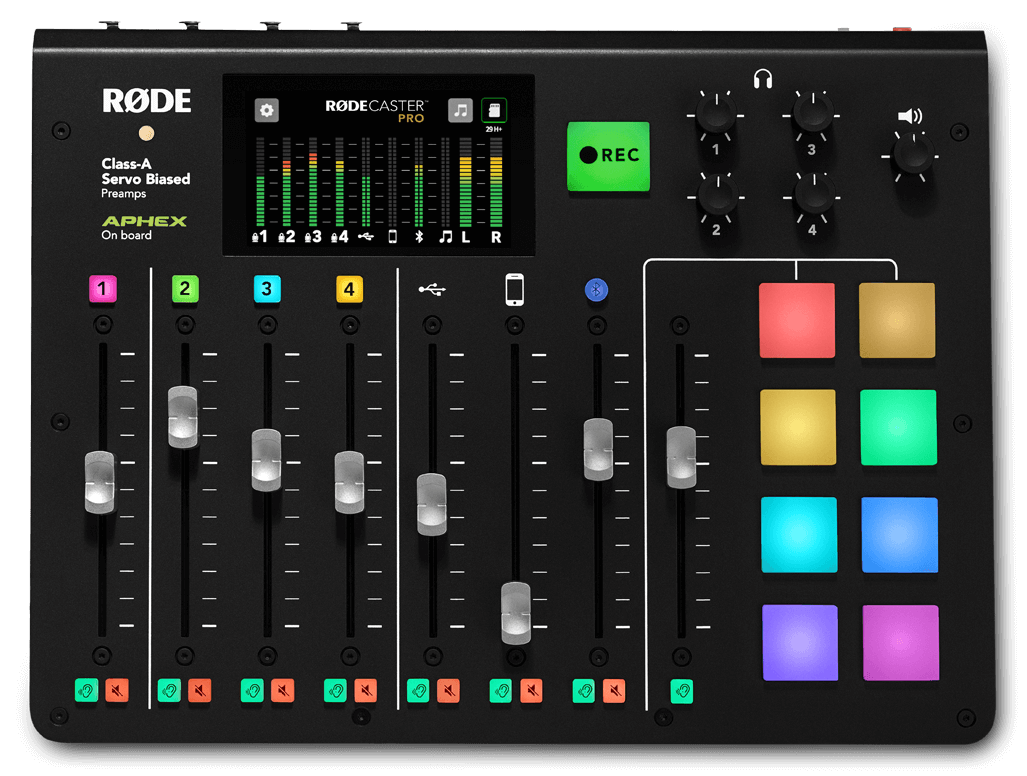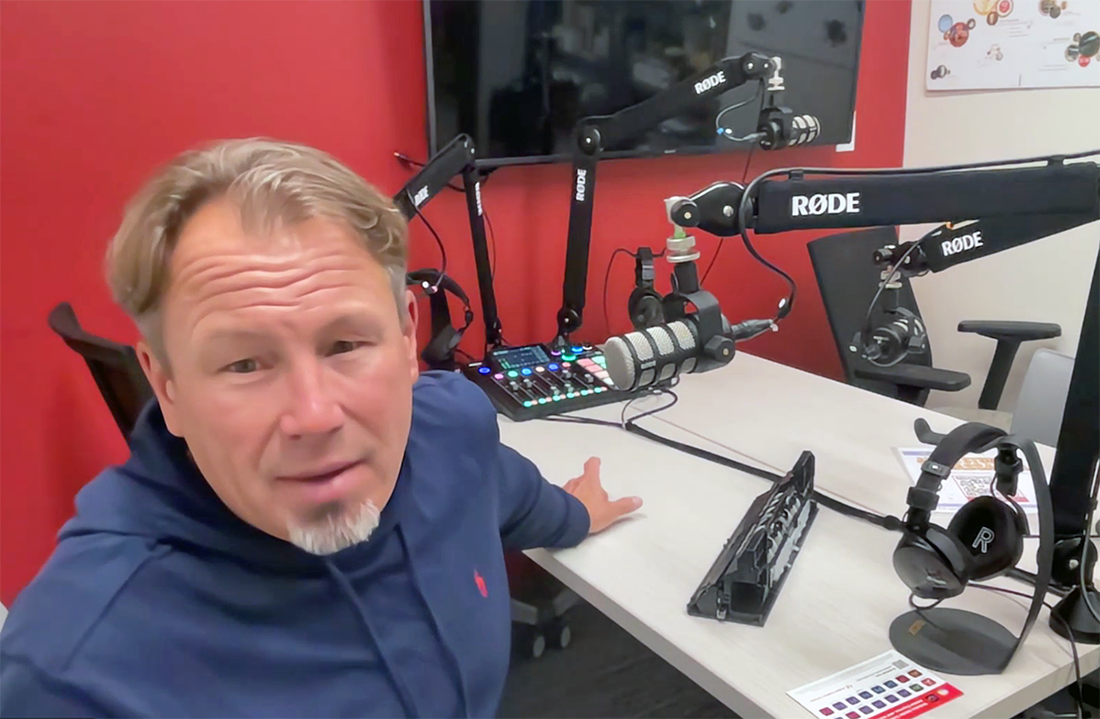New podcast studio opens in Kahlert Village

Drew Dennison, Adobe creative consultant, uses a new podcast studio in Kahlert Village. Image courtesy of Tony Sams.
In 2005, Apple cofounder Steve Jobs asked the audience at a tech conference who’d heard of podcasts. Bill Gates, cofounder of Microsoft, looked bemused, and hardly anyone raised their hands.
What was once fringe is now mainstream. Twenty years after the term “podcast” — a portmanteau of “iPod” and “broadcast” — was coined, 47% of Americans ages 12 and older listen to at least one podcast a month, according to a 2024 Edison Research report. As of June 2024, an estimated 4 million podcasts were registered around the world. Podcast enthusiasts tune in via a variety of services, including Apple, Google, Amazon, Audible, Spotify, and increasingly, YouTube.
“Podcasting is still very popular and definitely here to stay,” said Tony Sams, Learning Experience manager for UIT’s Digital Learning Technologies. Sams is personally drawn to podcasts that feature the kind of long-form investigative journalism his father wrote as a southeast region (Louisiana to Alabama) correspondent for the New York Times.
“I’m a sponge for information, and podcasts are a big part of my ongoing education,” he said.
Sams, who in 2009 launched Storyrobe, the first digital storytelling app for iOS devices, has provided training for the University of Utah community to record and edit podcasts for 17 years. His most recent contribution to podcasting production at the U is a newly completed podcast studio inside Kahlert Village, home of Adobe Creative Commons.
“By positioning it in Kahlert, where first-year students are housed, the new studio meets students where they’re at,” Sams said. “We’re really excited about that.”
The studio is outfitted with all the Rode brand components needed to record up to a four-person podcast, including:

RODECaster Pro II SMART pads (image courtesy of Rode)
- Four PodMic microphones
- Four sets of over-ear headphones
- Four omni-directional mic boom arms
- A production console that features:
- A nine-channel mixer
- Programmable SMART pads that perform voice effects and automated mixer actions like fade-ins and -outs
- Bluetooth connectivity and dual USB-C connectors that integrate with phone calls with guest speakers who use communications apps on their devices
- Color-coded buttons for quick identification of in-studio audio sources
The studio is capable of performing complex functions but is designed for easy use. In its simplest form, all prospective podcasters have to do is insert a thumb drive into a console Sams calls the “brains of the operation,” press a record button, record their podcast, and tap a stop button. No additional software is required. Once a podcast is recorded, the user takes their thumb drive home to, Sams said, “top and tail” the recording — which is tech-speak for trimming start and end points of a slice of audio. Sams recommends Adobe Audition, an audio editing tool available to faculty, staff, and students for free as part of the U’s Adobe Creative Cloud suite.
The podcast studio in Kahlert Village is one of three university-managed podcast spaces on campus. Marriott Library contains two podcast booths and a One Button Studio video production studio in its ProtoSpace on the second floor. An audio studio is located in the library’s Faculty Center on the first floor.
Marriott’s podcast booths are available for scheduling online. Kahlert Village’s studio will soon be available to schedule by scanning a QR code posted outside of the studio that will point to a Microsoft Bookings-based scheduling portal. In the meantime, Sams invites students, staff, and faculty to stop by the studio during regular office hours (11 a.m.-7 p.m. Mondays-Thursdays and 11 a.m.-5 p.m. Fridays) to request access and a brief demo.

Tony Sams, DLT Learning Experience manager, gives a virtual tour of Kahlert Village's new podcast studio.
Once online scheduling is available, Sams said, “based on all the other spaces I’ve built, I’m confident this will become highly used,” primarily because the plan is to ultimately give users UCard access and the freedom to record podcasts when creativity strikes.
“I imagine the studio will get a lot of use late at night. Sometimes you need a safe, isolated space to try it. When use is restricted to set hours, people can feel hesitant. They’re much more willing to express themselves creatively if they can fiddle with things when no one else is around.”
Sams pictures first-year students recording podcasts with their parents, for example, or faculty members recording podcasts as instructional material. He said this type of technology “enables faculty to engage with students who need alternatives to traditional presentation and writing formats.”
“Podcasting is the kind of multimodal learning that particularly benefits neurodiverse students,” Sams said. “Not only do we, as higher education professionals, need to meet students where they’re at, we need to adapt to how they learn.”
Once his team establishes scheduling via Bookings, Sams said they will announce a series of training workshops tailored specifically around the new podcast studio.
If you have questions about Kahlert Village’s new podcast studio, please contact Sams at 801-585-9780 or tony.sams@utah.edu.
Node 4
Our monthly newsletter includes news from UIT and other campus/ University of Utah Health IT organizations, features about UIT employees, IT governance news, and various announcements and updates.
